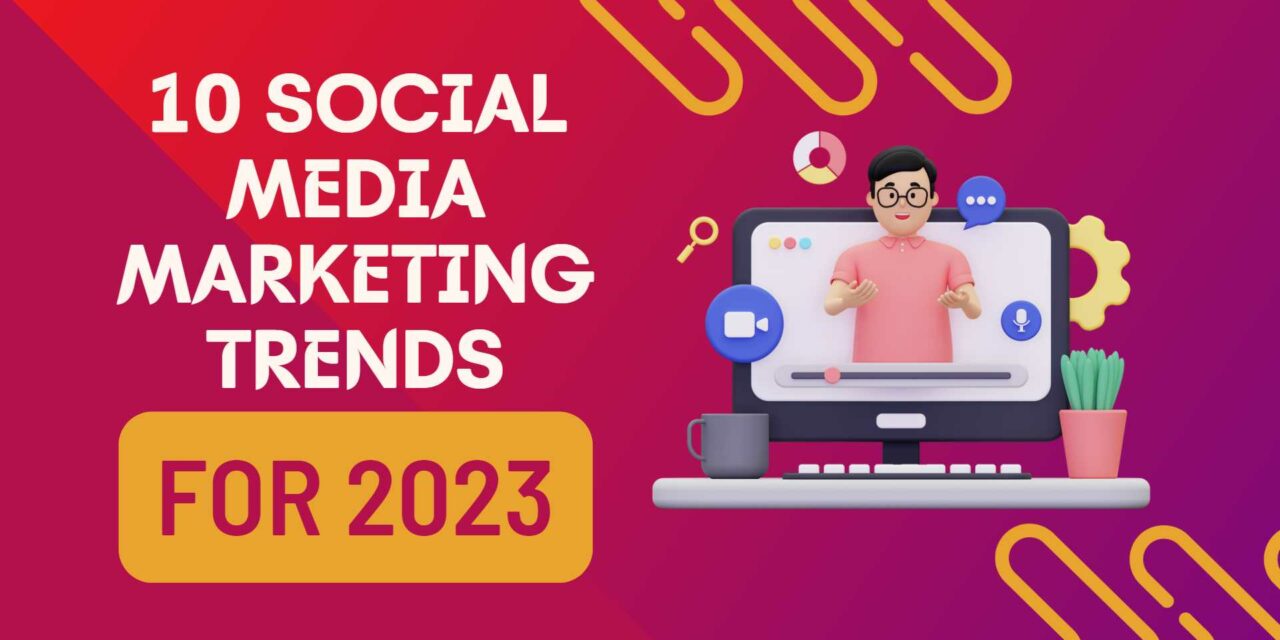The landscape of social media marketing is constantly changing. What worked a few years ago may not work today, and what works today may not work tomorrow. That’s why it’s important to stay ahead of the curve and keep up with the latest trends. In this blog post, we will discuss 10 social media marketing trends that you need to watch out for in 2023!
Social media is always changing – and 2023 is set to be another big year of change with new opportunities for creative marketers.
The social media landscape is always evolving, and 2023 looks set to be another big year of change with new opportunities for creative marketers. Here are some of the key trends to watch out for:
Increased use of AI and automation
As artificial intelligence (AI) and automation become more sophisticated, they will increasingly be used to help manage social media accounts and create content. This will free up time for social media managers to focus on other tasks, such as strategy and engagement.
More focus on TikTok
TikTok has exploded in popularity in recent months, and it looks set to continue to grow in 2023. Brands that are not already on the platform should consider creating content for it, as it offers a great way to reach a young audience.
Greater emphasis on Stories
Stories are a popular feature on social media platforms such as Snapchat and Instagram, and they are only going to become more important in the coming year. Brands should experiment with different types of Stories content to see what works best for them.
More use of AR and VR
Augmented reality (AR) and virtual reality (VR) are two technologies that are slowly gaining traction on social media. As more people start using AR and VR devices, we will see an increase in the number of brands using these technologies to create immersive content experiences.
Greater diversity in content types
There will be a greater diversity of content types on social media in 2023, as platforms continue to expand their offerings. We will see more live video, user-generated content, and interactive content, among other things.
1. The Key performers in 2023
- The rise of TikTok and other short-form video platforms: With the increasing popularity of short-form video platforms like TikTok and YouTube Shorts, we expect to see more brands and businesses using these platforms to reach their target audiences.
- The continued growth of live streaming: Live streaming is becoming increasingly popular, with platforms like Twitch and YouTube Gaming growing in popularity. We expect to see more businesses using live streaming to connect with their audiences in real-time.
- The rise of influencer marketing: Influencer marketing is expected to continue to grow in popularity, as businesses look to connect with their target audiences through social media influencers.
- The growth of video content: Video content is becoming increasingly important on social media. We expect to see a huge upswing in the use of video content to connect with all social media audiences. All social media platforms are looking for ways to keep their audiences attention longer and longer. Video is the best way to keep someone’s attention and we are seeing all platforms push this harder and harder.
- The explosion of social media advertising: Social media advertising is expected to grow in popularity as businesses look to reach their specific target audiences through paid ads on social media platforms.
- The growth of social commerce: Social commerce, or the ability to purchase products directly from social media platforms, is expected to grow in popularity in the coming years.
- The rise of chatbots: Chatbots are expected to become more popular as businesses look to use them for customer service and support on social media platform

2. The need to be Authentic and relatable
Authenticity and relatability are important for content creators because they help build trust with their audience. Community-led content is also important because it can help create a sense of belonging and connection. Originality is another key element that will become even more important in the future. This is because audiences are becoming more savvy and are able to spot copied or fake content from a mile away.
As content creators, we need to be aware of these trends and adjust our strategies accordingly. We need to create content that is not only authentic and relatable, but also original and community-led. Only then will we be able to build trust and connection with our audience.
Authenticity and relatability will continue to be important, but community-led content and originality will become even more so
3. A shift towards more personalized content
There is no doubt that the internet has changed the way we consume content. In the past, we would typically read newspapers or watch the news on television. This would give us a broad overview of what was happening in the world, but it was not always tailored to our specific interests.
Nowadays, we can log onto our laptops, tablets or phones and find content that is much more personalized to us. We can follow specific channels or topics that we are interested in, and receive updates on those topics whenever they happen. This shift towards more personalised content means that we are no longer limited to the mainstream sources of information.
There are a number of reasons why this change has occurred. Firstly, the internet gives us access to a far wider range of content than traditional media sources. We can find articles, videos and podcasts from all over the world with just a few clicks. Secondly, social media platforms such as Facebook and Twitter allow us to share content with our friends and family, and receive recommendations based on our interests. Finally, online publishers can track our behaviour and use data analytics to show us content that we are more likely to engage with.
This change has had a number of impacts on both individuals and society as a whole. On an individual level, we now have much greater control over the information that we consume. We no longer have to rely on broadcasters to tell us what is happening in the world; instead, we can seek out news and opinion pieces that reflect our own views and beliefs. This has led to a more diverse range of voices being heard online, as people from all walks of life can now share their thoughts and ideas with a global audience.
On a societal level, this increased access to information has made us more informed about the world around us. We can learn about events as they happen, rather than waiting for the news cycle to catch up. We can also access a wider range of opinions on current affairs, giving us a more rounded view of complex issues. This increased understanding of the world around us can lead to more informed decision-making at both a personal and political level
4. More focus on user-generated content (UGC)
User-generated content, or UGC, is a form of content that is created and published by users of a product or service, rather than the brand or company itself. This can include anything from reviews and testimonials to social media posts and blog comments.
The rise of social media has been a major factor in the growth of UGC, as it gives users a platform to share their thoughts and experiences with a wider audience. In many cases, UGC is seen as more trustworthy than traditional marketing messages, as it comes from real people who have used the product or service themselves.
There are several benefits of using UGC for businesses. Firstly, it can help to build trust and credibility with potential customers. Secondly, it can be a great source of ideas and feedback, allowing businesses to improve their products and services based on real-world usage. Finally, UGC can be an extremely cost-effective form of marketing, as it relies on word-of-mouth promotion rather than paid advertising.
So if you’re looking for ways to connect with your customers and promote your business, consider incorporating some user-generated content into your marketing mix!
5. A move away from perfect, polished images
Over the past few years, there has been a shift away from perfect, polished images and towards more natural, imperfect ones. This is likely due to a number of factors, including the increasing popularity of social media platforms like Instagram and Snapchat, which encourage users to share raw, unedited photos and videos. Additionally, as people become more aware of the unrealistic standards of beauty that are often perpetuated by the media, they are seeking out more realistic images that they can relate to.
This trend is evident in both professional photography and amateur photography. Professional photographers are now eschewing traditional photo editing techniques in favor of ones that create a more natural look. And amateur photographers are increasingly using their phones and other devices to take candid shots that capture everyday moments, rather than posed pictures that try to capture perfection.
This move away from perfect, polished images is a refreshing change. It allows us to see the world around us in a more realistic way, and it helps us to appreciate the beauty in everyday life.

6. An increase in short-form video content
There’s no doubt that short-form video content is on the rise. From TikTok to YouTube Shorts to Facebook and Instagram Reels, more and more people are consuming content in short, bite-sized pieces. And there are a number of reasons for this.
For one, short-form video content is incredibly easy to consume. People can watch a short video and get the gist of it without having to commit a lot of time to it. This is perfect for people with busy schedules or who want to consume content on the go.
Another reason why short-form video content is so popular is because it’s often more engaging than other types of content. A well-produced short video can be much more captivating than a long blog post or article. And since people have shorter attention spans these days, this is an important consideration. Also, short-form video content is often more shareable than other types of content. This means that it has the potential to reach a wider audience and have a greater impact.
Finally, TikTok and YouTube Shorts have announced they will be allowing creators to participate in the monetization of short-form video content in early 2023 so it’s likely we will see an explosion of content creators looking to take advantage of this new income potential. So if you’re looking to create content that will reach and engage your audience, consider creating some short-form videos. They just might be the perfect solution for you.
7. A need for more real-time marketing
The internet has changed the way that marketing works. In the past, marketing was about creating a message and then broadcasting it as widely as possible. Today, marketing is about creating a relationship with your customers and then engaging with them on a one-to-one basis.
Real-time marketing is all about being able to respond to customer needs and queries as they happen. This means being active on social media, monitoring online conversations, and generally being aware of what is going on in the world at all times.
It can be a challenge to keep up with real-time marketing, but it is essential if you want to stay ahead of the competition. Here are some tips to help you get started:
- Monitor social media closely. Social media is where most real-time conversations are happening. You need to be active on all the major platforms, including Twitter, Facebook, and Instagram. Use social media monitoring tools to help you keep track of what is being said about your brand.
- Be responsive. When someone mentions your brand on social media, make sure you respond quickly. This shows that you are listening and that you care about your customers.
- Have a plan. Don’t just wing it when it comes to real-time marketing. Have a plan in place so that you know how you will respond to different situations. This will help you maintain control of the conversation and avoid making any mistakes.
- Be prepared to change course. Real-time marketing requires flexibility. If something isn’t working, be prepared to change course quickly.
- Be creative. Real-time marketing is all about stand-out content. If you can be creative and produce content that is truly amazing, people will take notice and share it with their friends.
8. A focus on micro-influencers
Micro-influencers are social media users with a relatively small but engaged following and they can be a great “cheat-code” for your marketing. Unlike celebrity influencers with millions of followers, micro-influencers have a more intimate relationship with their followers. This allows them to be more relatable and trustworthy, which can result in higher engagement rates.
There are several benefits of working with micro-influencers. First, they are often more affordable than celebrity influencers. Second, they can reach a more targeted audience since their followers tend to share similar interests. Third, they typically have high engagement rates, meaning that their posts are more likely to be seen and interacted with by their followers.
When working with micro-influencers, it is important to consider the size of their following, their engagement rate, and the relevancy of their audience. Micro-influencers with a smaller following may be less expensive but may also have less influence. Those with a higher engagement rate are more likely to generate results, but may be more expensive as well. It is also important to consider the relevancy of an influencer’s audience when selecting them for a campaign. For example, if you are promoting a product that is targeted towards millennials, it would make sense to select an influencer whose followers are mostly millennials.

9. A rise in ephemeral content
Ephemeral content is content that disappears or expires after a certain amount of time. This type of content is often used on social media platforms, such as Snapchat and Instagram, where users can share photos and videos that vanish after 24 hours. Ephemeral content is popular because it allows users to share information without the pressure of permanence. It also creates a sense of urgency and encourages people to consume content while it is still available.
While ephemeral content may disappear, it does not mean that it is gone forever. Users can take screenshots of images and videos, and companies can save or archive this type of content. Ephemeral content can also be repurposed for other platforms or channels. For example, a news outlet may take a screenshot of an Instagram story and share it on their website or Twitter account.
The rise in ephemeral content is due to the popularity of social media platforms that use this format. Snapchat was one of the first platforms to popularize ephemeral content, and Instagram has followed suit with its own version called Stories. These types of content are popular because they allow users to share information in a more informal way. Ephemeral content is also convenient for people who want to consume content on-the-go or in short bursts.
Although ephemeral content may disappear, it can still have a lasting impact. This type of content allows people to share information in a more creative and personal way. It also encourages people to consume content while it is still available, which creates a sense of urgency.
10. Greater transparency around data and privacy
The internet has become a staple in most people’s lives. It is hard to go anywhere without seeing people on their phones or laptops. With this increased dependence on technology comes increased concern for data and privacy. Users are becoming more aware of how their data is being used and shared, and they are demanding greater transparency from companies.
Most internet users are not aware of the ways their data is being collected and used. Companies have been collecting user data for years, but it has only recently come to light how much they actually have. This has led to a lot of concern from users about their privacy. Users are now demanding that companies be more transparent about the ways they collect and use data.
Companies are starting to respond to these demands by becoming more transparent about their data practices. They are now providing more information about how they collect and use data. They are also giving users more control over their data. This is a positive step forward, but there is still more work to be done.








